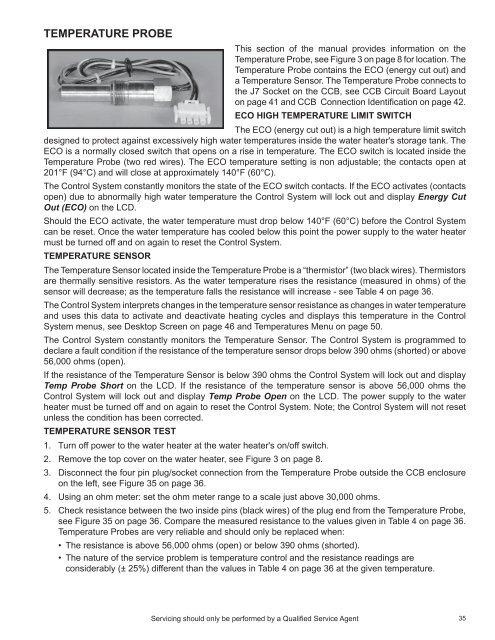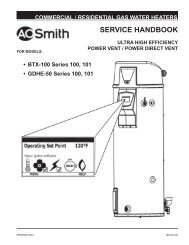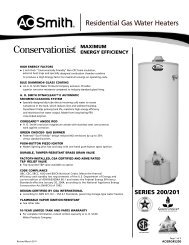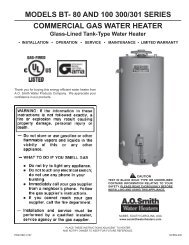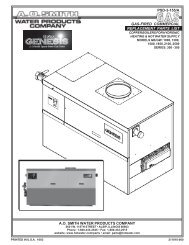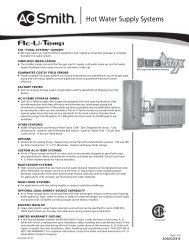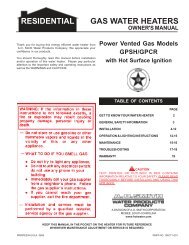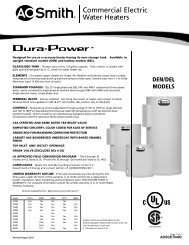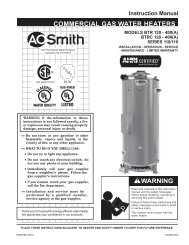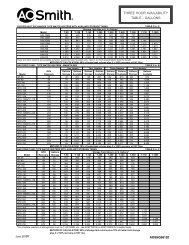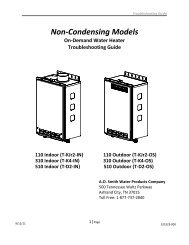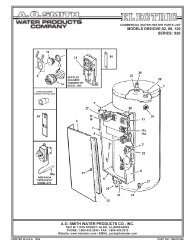Service Handbook - AO Smith Water Heaters
Service Handbook - AO Smith Water Heaters
Service Handbook - AO Smith Water Heaters
Create successful ePaper yourself
Turn your PDF publications into a flip-book with our unique Google optimized e-Paper software.
Temperature Probe<br />
This section of the manual provides information on the<br />
Temperature Probe, see Figure 3 on page 8 for location. The<br />
Temperature Probe contains the ECO (energy cut out) and<br />
a Temperature Sensor. The Temperature Probe connects to<br />
the J7 Socket on the CCB, see CCB Circuit Board Layout<br />
on page 41 and CCB Connection Identification on page 42.<br />
ECO High Temperature Limit Switch<br />
The ECO (energy cut out) is a high temperature limit switch<br />
designed to protect against excessively high water temperatures inside the water heater's storage tank. The<br />
ECO is a normally closed switch that opens on a rise in temperature. The ECO switch is located inside the<br />
Temperature Probe (two red wires). The ECO temperature setting is non adjustable; the contacts open at<br />
201°F (94°C) and will close at approximately 140°F (60°C).<br />
The Control System constantly monitors the state of the ECO switch contacts. If the ECO activates (contacts<br />
open) due to abnormally high water temperature the Control System will lock out and display Energy Cut<br />
Out (ECO) on the LCD.<br />
Should the ECO activate, the water temperature must drop below 140°F (60°C) before the Control System<br />
can be reset. Once the water temperature has cooled below this point the power supply to the water heater<br />
must be turned off and on again to reset the Control System.<br />
Temperature Sensor<br />
The Temperature Sensor located inside the Temperature Probe is a “thermistor” (two black wires). Thermistors<br />
are thermally sensitive resistors. As the water temperature rises the resistance (measured in ohms) of the<br />
sensor will decrease; as the temperature falls the resistance will increase - see Table 4 on page 36.<br />
The Control System interprets changes in the temperature sensor resistance as changes in water temperature<br />
and uses this data to activate and deactivate heating cycles and displays this temperature in the Control<br />
System menus, see Desktop Screen on page 46 and Temperatures Menu on page 50.<br />
The Control System constantly monitors the Temperature Sensor. The Control System is programmed to<br />
declare a fault condition if the resistance of the temperature sensor drops below 390 ohms (shorted) or above<br />
56,000 ohms (open).<br />
If the resistance of the Temperature Sensor is below 390 ohms the Control System will lock out and display<br />
Temp Probe Short on the LCD. If the resistance of the temperature sensor is above 56,000 ohms the<br />
Control System will lock out and display Temp Probe Open on the LCD. The power supply to the water<br />
heater must be turned off and on again to reset the Control System. Note; the Control System will not reset<br />
unless the condition has been corrected.<br />
Temperature Sensor Test<br />
1. Turn off power to the water heater at the water heater's on/off switch.<br />
2. Remove the top cover on the water heater, see Figure 3 on page 8.<br />
3. Disconnect the four pin plug/socket connection from the Temperature Probe outside the CCB enclosure<br />
on the left, see Figure 35 on page 36.<br />
4. Using an ohm meter: set the ohm meter range to a scale just above 30,000 ohms.<br />
5. Check resistance between the two inside pins (black wires) of the plug end from the Temperature Probe,<br />
see Figure 35 on page 36. Compare the measured resistance to the values given in Table 4 on page 36.<br />
Temperature Probes are very reliable and should only be replaced when:<br />
• The resistance is above 56,000 ohms (open) or below 390 ohms (shorted).<br />
• The nature of the service problem is temperature control and the resistance readings are<br />
considerably (± 25%) different than the values in Table 4 on page 36 at the given temperature.<br />
Servicing should only be performed by a Qualified <strong>Service</strong> Agent<br />
35


